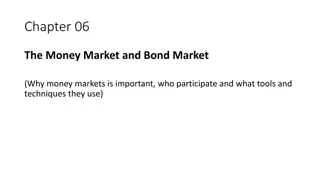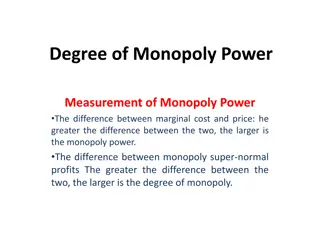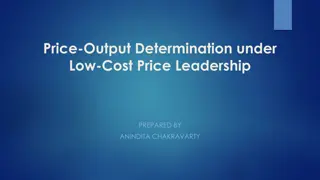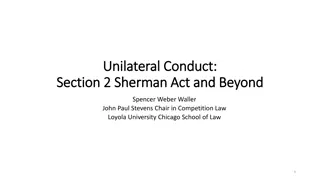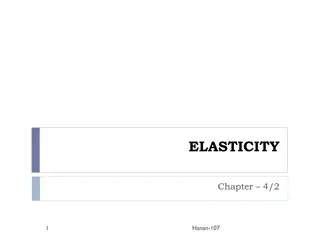Understanding Price Discrimination in Monopoly Markets
Price discrimination under monopoly occurs when businesses charge different prices to different consumer groups for the same product or service. Conditions for price discrimination include monopoly power, market segmentation, ability to separate consumer groups, and prevention of resale. Examples of price discrimination in action include market haggling, mobile phone tariffs, taxi fares, hairdresser discounts, and educational bursaries. Profitability of price discrimination depends on increasing consumer willingness to pay. Factors influencing price discrimination include nature of the commodity, distance between markets, consumer ignorance, governmental regulations, geographical differences, elasticity of demand, and artificial distinctions between products.
Download Presentation

Please find below an Image/Link to download the presentation.
The content on the website is provided AS IS for your information and personal use only. It may not be sold, licensed, or shared on other websites without obtaining consent from the author. Download presentation by click this link. If you encounter any issues during the download, it is possible that the publisher has removed the file from their server.
E N D
Presentation Transcript
Price Discrimination under Monopoly Prof. Saptarshi Chakraborty Taradevi Harakh Chand Kankaria Jain College Cossipore, Kolkata-700002
Outlines of topic: Outlines of topic: Price Discrimination Conditions of Price Discrimination Price Discrimination in action Degrees of Price Discrimination
Price Discrimination Price Discrimination Price Discrimination occurs when a business charges a different price to different group of consumers for the same good or services. Examples: 1. Occupational Discounts: this price discrimination is present when individuals receive certain discounts based on their occupation. 2. Time of Purchase: that price discrimination we get with the help of time in some conditions. and many other examples are also there.
Conditions for Price Discrimination Conditions for Price Discrimination Firms must have sufficient monopoly (market) power: Monopolists always have pricing power price makers not takers Identifying different market segments: Consumers with different price elasticities of demand Ability to separate different groups: Requires information / sufficient market intelligence. Ability to prevent re-sale(Arbitrage): No secondary markets where arbitrage can take place at intermediate prices e.g. Limiting sales, age-restrictions, ID cards.
Price Discrimination in Action Price Discrimination in Action 1. Market Haggling. 2. Mobile phone contracts / tariffs 3. Taxi fares at peak times of the day 4. Hairdresser discounts 5. Educational bursaries
When is Price Discrimination is profitable? When is Price Discrimination is profitable? Price Discrimination is profitable only when the percentage change in surplus associated with a commodity upgrade is increasing the consumer willingness to pay, i.e. total consumer s willingness to pay less the firms costs.
When Price Discrimination is possible: When Price Discrimination is possible: Nature of commodity Distance of two markets. Ignorance of consumers. Governmental regulation. Geographical Discrimination Difference in elasticity of demand Artificial difference between commodities.
Types of Price Discrimination Types of Price Discrimination First degree Price Discrimination. Second Degree Price Discrimination. Third Degree Price Discrimination.
First Degree Price Discrimination It isthe practice of charging each consumer the maximum amount he/she is willing and able to pay. First Degree Price Discrimination occurs when each unit of output is sold at a different price such that all consumer surpluses go to the seller. It is also known as Perfect Price Discrimination. Make consumers pay the maximum amount for the same thing for which other is giving less amount. Consumer suplus is taken by the supplier.
Second Degree Price Discrimination In this prce varies according to quantity sold. When large number of quantity is sold then the unit price of the commodity is low and if less number of quantities is sold then the unit price is higher for the same quality of the goods and services. It is also known as Economies of Scale. Example: when you buy 1 kg apples , you will cost more amount than when you buy whole box of apples. It is mostly useful for industrial people but not for a common person.
Third Degree Price Discrimination Third Degree Price Discrimination Price varies by consumer segment. Third Degree Price Discrimination occurs when different prices are charged to groups of buyers. It can seem unfair to pay more than somebody else for the same good. Some suffers and some are able to afford to buy.
THE END THE END THANK YOU






